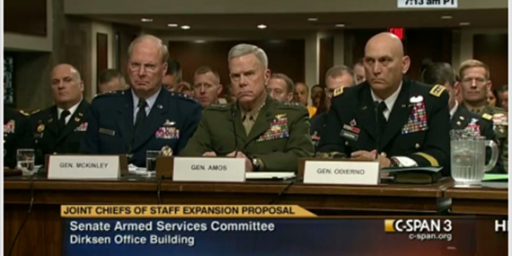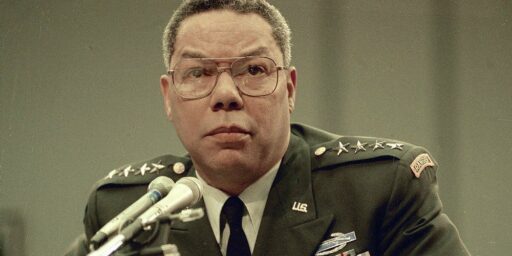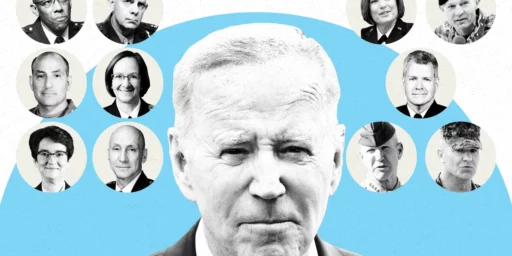JOINT CHIEFS TALK
Day 2 of the IPFA-Fletcher conference featured several interesting and prominent speakers, including the Chairman and all the service chiefs or their representatives. I didn’t learn a great deal that I didn’t already know but came away with an increased sense that jointness (interoperability between the Army, Navy, Air Force, etc.) is now a reality rather than a buzzword. Indeed, they’re now searching for new terminology to capture the reality that the defense department must be seamlessly integrated with not only our allies and coalition partners (traditionally, “combined”) but also with non-military organizations in the U.S. (non-DOD intel, Homeland Security, etc.) and abroad.
The opening session was a one-hour presentation by retired Vice Admiral Art Cebrowski, the Director of the Office of Force Transformation. He wrote the pionering piece on Network Centric Warfare which appeared in Proceedings a few years ago. His presentation is rather hard to encapsulate because he touched on so many concepts.
His main theme was that the rules by which we organize, train, and equip our military must transform. He continually used business analogies, noting that we are beyond the days of the industrial age military and even the on-time delivery model. Instead, he sees us moving toward a flat, non-hierarchical model that is infinitely adaptable. He notes that the high tech arena, while giving us awesome firepower and precision, creates an enormous burden on our C4ISR (command, control, communications, computers, intelligence, surveillance, and reconnaisance) and logistical capacity. The problem with ISR isn’t so much that we can’t get the information we need but rather that we can’t process it quickly enough. The end result, he believes, is that all soldiers–and indeed, all involved in defense loosely defined–in effect become intel analysts. He likens this to the evolution in telecom in the 1940s or so when the switchboard operator model for telephones was being overwhelmed. Over time, with the help of electronics, we all became our own telephone operators. And eventually our own installers. Likewise, our ability to fight at rapid pace means we constantly overshoot our own logistics, as happened in Operation Iraqi Freedom (OIF). To overcome this, the log train must shift to a push model, and get the stuff out before the troops need it, with units actually trading amongst themselves to fill needs and compensate for over- and under-supply.
He believes the primary mission of the military is now “exporting security” rather than defense in a traditional sense, and that this will necessitate radical changes in the mindset of the force. The “warrior” mentality, which set in in the 1980s as a reaction to the Vietnam malaise, is great for the warfighting model but tends to create stovepipes.
The second session featured the service chiefs, minus the Chairman, who was our luncheon speaker.
GEN Mike Hagee, the USMC Commandant, spoke first. He opened by quoting from a new book on OIF that observed it was impossible to “grade” the “air war” because it was so seamlessly integrated into the ground operation. In a phrase that became widely repeated by several speakers, he contended that Desert Storm was joint in the sense of being “de-conflicted”–the services not getting into one another’s way. OIF had pushed it to the point of actual interdependence. Several minor campaigns during that interim–notably the non-invasion of Haiti where Army helicopters were set to launch from Navy carriers–helped achieve that transformation. His other major point–and one bought into by the others later in the Q&A–was a radical increase in sea basing of operations, not just for troop deployment but for staging, assembly, and even logistical supply.
GEN Peter Schoomaker, the Army Chief of Staff, was next. He showed a slide of the “Soldier’s Creed,” and emphasized the fundamental role of the individual soldier, sailor, airman, marine, and coastguardsman–a recurrent theme both days. He talked quite a bit about the need to rework the AC-RC balance so that we have the “right” kind of forces in the active and reserve force. He told us that a Stryker Brigade is now in theater and will be operation in Iraq within 30 days. He also noted that the Army currently has forces deployed in 120 countries, a rather remarkable figure and certainly much higher than I would have guessed.
VADM Thomas Barrett, the Vice Commandant of the Coast Guard, focused his talk on what he termed the “four lanes” of transformation: authorities (increased legal authority to conduct interdiction and otherwise increase martime security), capabilities (increased C4ISR and recapitalization of vessels to make them more interoperable), capacity (more of the resources needed for the increased mission posture), and partnership (the joint-combined-plus concept I noted in the intro). Interestingly, he was the only one who thought he needed more resources to do his job. All others were adament that we need to actually downsize their forces to transform, even under heated questioning.
LTG Duncan McNabb, the Deputy Chief of Staff for Plans and Programs of the Air Force was by far the most junior member of the panel. He tread over a lot of the same ground as the others–not surprising given the order. The most interesting point he made was what he termed “kill chain compression.” He noted that from the time the JDAM strike on Saddam’s bunker that opened the war was approved to rounds on target was 14 minutes–an extraordinary accomplishment. The problem was that it took 43 minutes from the time intel identified the target of opportunity to get permission. While this is still remarkably fast, given that it was a presidential decision to radically alter the war’s timetable, it is probable that we would have “gotten” Saddam had we hit just a few minutes earlier. The difficulty–and this was a running theme throughout the conference–is that speeding things up much more requires bypassing the entire chain of command hierarchy–in essence trusting the Tech Sgt. who made the call to get permission to make the judgment on his own. We’re not there yet.
Adm. Vern Clark, the Chief of Naval Operations, exercised host’s priviledge and spoke last. His talk was more a wrap-up than provision of new information. His main theme was the value of readiness. He recalled the poignancy of President Bush pointing to the Chiefs in the 2002 SOTU and saying simply, “Be ready.” Unlike the old days–of even five years ago–we simply can’t have a handful of units that are rapidly deployable and then train up other units to backful. Given the opstempo and the uncertainty of the threat environment, virtually all of the active force and a good chunk of the reserve force has to be fully manned, equipped, and trained at any given moment. He made a cryptic reference to the outdated Cold War era personnel management system, which he didn’t really explain, but noted that it applied to both DOD and the relevant civilian agencies.
Finally, GEN Richard Myers, Chairman of the JCS, was the luncheon speaker. He reiterated and reemphasized many of the themes his chiefs made in the earlier panel. His main point seemed to be that transformation wasn’t so much about more gee-whiz gizmos but about breaking old ways of thinking. He did, however, mention a couple of gizmos, notably Dragoneye, a 4-pound UAV that costs less than $70,000 that is a superb short-range recon tool, and J-PEN, the Joint Protection Enterprise Network.
I had never heard of the last one, and apparently few in the audience had either. Basically, it’s a very cheap software program that DOD bought off the shelf and did some slight mods to that solved a major problem: sharing discrete bits of information across DOD and with various civilian agencies–including federal, state, and local. It’s apparently fully scalable and adaptable to the needs of the end user, so that “sensitivity” levels can be altered. The idea is that little bits of information that might lead to suspicion about threats tend not to get passed around quickly enough because everyone is waiting to put the puzzle together first. As we now know, we might have prevented 9/11 had something like this been in place. What’s really remarkable is that, rather than the standard DOD model of testing this thing for years and then spending billions on R&D, it went 90 days from concept to prototype and another 60 days to fielding.
Update (2208): I’ve spent a little over a decade studying this issue, starting with a paper I wrote in grad school about the need for more MPs and civil affairs forces–and fewer Marines–in Operation Restore Hope in Somalia (the first time, where it was humanitarian, rather than the unfortunate warlord chasing intervention), culminating in a dissertation on defense reorganization that I completed in late 1995. My findings were that the military had steadfastly refused to transform itself, despite all manner of pressure from presidents on down, since World War II. This held true well after the dissertation and I wrote an article for Armed Forces & Society* restating much of this in early 2002, noting that the September 2001 QDR payed lip service to change without actually calling for much. While some of this is still true (most egregiously, our woeful underprovision of strategic lift capacity), I’m now convinced that the decisionmakers at all levels–SECDEF, the Joint Chiefs, and Congress–actually finally “get it.” Interservice rivalry still exists, as does a ridiculous amount of unnecessary redundancy (notably in the service support areas). But they all finally realize that they’re all playing for the same team.
*I got a “revise and resubmit” and never got around to the revision after leaving academe.






Wow, that’s a hell of a post James.
One can only wonder the “force multiplier” effect of having all the branches finally operating as a “team.”
As a citizen, a tax payer and (dare I say) a target of terrorists, I’m real glad these guys are on my team.
It’s a shame the incredible advances we are making in this area are being ignored in favor of word parsing over who said who was buying yellow cake where, who’s protesting what and assorted other meaningless crap.
—